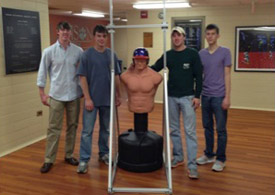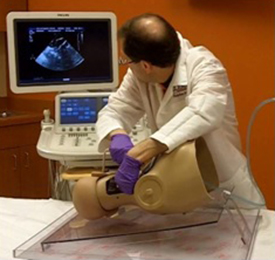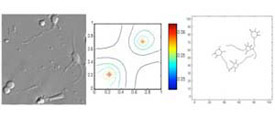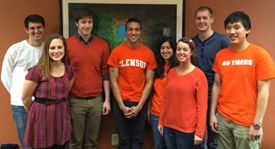Previous Creative Inquiry Projects
Redesigning Medical Training Simulators
Our Creative Inquiry team re-engineers medical training simulators used by medical students and residents. Many simulators have limitations and glitches, and our goal is to eliminate these so that future physicians can safely and effectively treat patients. Our current project, a patent-pending central venous catheterization simulator, is in the testing phase to prepare for marketing. We will be starting a new project in the spring of 2014 to work on over the next few semesters. We hope to create another cost effective simulator that can be used by medical programs nationwide. This is a great opportunity for undergraduate students to gain experience in research and product development.
MACOBE: Can Cells Solve Mazes?
Wound healing is a complex process that occurs after the body's tissue has been damaged or impaled by a foreign object. In proper wound closure, cells must migrate from all over the body to a site of injury to progress the wound from one stage of healing to the next. Fibroblasts are one of the many cells involved in reconstructing the tissue following injury. Our creative inquiry is studying the growth and migration of fibroblasts in a complex environment. We have addressed this asking the question: can cells solve mazes? We have developed several methodologies by which we can test the cells responsiveness to physical and chemical concentration gradients. The current goal is to develop a predictive model to be used in development of new treatment options for wound therapies.
Robotics and Bioengineering
with Dr. David Kwartowitz
The robotics in bioengineering CI has many exciting projects that are currently being developed. The two main projects being pursued include a set of slot cars that can be driven by flexing your biceps as well as a device that allows a user to control a PowerPoint presentation hands free with only eye movements. The group has used these projects towards their research. The aim of the research is to test the effects of hands on demos on young students' interest in various engineering disciplines.
http://www.youtube.com/watch?v=AYuoabbs-ho
Dental Pulp Cells and Materials for Dental Regeneration
Our creative inquiry focuses on different aspects of teeth, and there are three divisions of our creative inquiry group. The first group studies how common whitening treatments play a role in the wear and deformation of mottled enamel compared to normal enamel. They are also exploring the effect whitening treatments have on the surface properties of dental enamel. The second group is exploring the effects of cleaning methods on substrates which dental pulp stem cells are grown on. Specifically they are looking at gold-plated silicon wafers cleaned with piranha solution. The last group focuses on encouraging dental pulp stem cells to differentiate into odontoblasts-like cells by culturing them on hydroxyapatite and Fluorapatite particles.


Roper Mountain Science Center Innovative Laboratory
Roper Mountain Science Center (RMSC) is a center in Greenville, SC, devoted to science enrichment through interactive and informative displays. Founded in 1984, the center has been a place of learning for elementary and middle schools throughout the Upstate. However, the exhibits are in desperate need of updating. Through funding by the South Carolina government, a grant has been secured for renovations. Seven hundred square feet of the museum will be devoted to biomedical engineering and nanotechnology. This creative inquiry focuses on developing technologically advanced displays targeted to seventh grade students that engage and excite them in the field of biomedical engineering. One interactive display we are working on involves relating high impact collisions in sports and concussions. It will show the students the importance wearing protective helmets in sports, and allow them to design their own helmets for testing. The exhibit includes a helmet wearing dummy, a dropping mechanism simulating typical impacts associated with concussions, an accelerometer measuring the forces the dummy experiences, and an output showing if a concussion occurred. Another exhibit that the Roper Mountain Creative Inquiry Team is working on is a Camera Assisted Surgery Simulator. This will allow students to practice performing a surgery type event while viewing their actions through a camera.
http://ropermountainci.weebly.com/
Mapping Amino Acids on Protein Surfaces
Spider silk is a unique and somewhat mysterious biological molecule in that extensive information on its mechanical and surface properties have eluded scientists. The ultimate goal of fabricating synthetic fibers with properties that resemble spider silk starts with understanding the properties which make these fibers unique. The mechanical properties of the spider silk are studied using various tensile tests of the fiber. Through the use of atomic force microscopy, information concerning the silks surface and internal structures can be revealed. Other properties like the tendency of the silk to super contract upon interaction with a solvent are also studied on this project.To the right are a few images of our work. The first image shows a sample of dragline silk that is being prepared for AFM imaging. The second is an image of the spinnerets of a spider and the actual silking process. The last image is an AFM scan of the silk fiber and it shows the topography of the silk surface.

Hands on Tissue Engineering
Section A: In current, mono-layer cell culturing techniques, intracellular interactions are reduced and many cell functions are not expressed. By maintaining intracellular interactions via 3-dimensional culturing techniques, gene expression better mimics the tissue and serves as a more accurate representation of in vivo conditions. Understanding, creating, and utilizing 3-dimensional cell culturing techniques opens pathways into better drug testing and tissue engineering. Our research focuses on creating an efficient method to culture predictable spheroids and using these spheroids for tests in the aforementioned areas; namely testing of cancer-related drugs and quantifying the synthesis of certain tissue-related products from different cell types (i.e. collagen production from fibroblast spheroids). Our hope is to not only contribute to the development of an innovative, predictable 3D cell culturing method, but to also use the spheroids to advance the testing of drugs and understand cellular interaction for use of tissue engineering.
Section B: Current cell culture techniques require trypsin, which compromises cell membrane integrity and kills cells over time. The goal of this project is to develop a new method of cell-surface dissociation by culturing cells on photovoltaic surfaces coated with charged proteins. To passage cells, the photovoltaic surface will be exposed to light, inducing a current. The current will electrostatically repulse the charged proteins, causing the proteins and cells to dissociate from the surface and float in suspension. This technique would be especially useful for pharmaceutical companies or for researchers who want to study specific cell membrane proteins.











